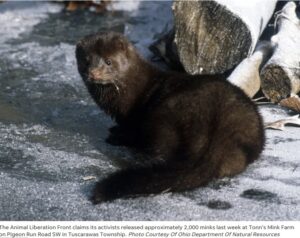Steven M. Grazier
Massillon Independent
- An animal activist groups is claiming responsibility of the release of about 2,000 mink last week in Stark County.
- American Liberation Front says activists opened several mink cages July 3 at Tonn’s Mink Farm in Tuscarawas Township.
- Dennis Tonn, owner of the farm, said July 7 that nearly 600 mink are still missing.
 An animal rights group is taking credit for releasing about 2,000 mink last week at a western Stark County farm.
An animal rights group is taking credit for releasing about 2,000 mink last week at a western Stark County farm.
The Animal Liberation Front claims that its activists opened several mink cages July 3 at Tonn’s Mink Farm, using wire cutters after entering the property through a fence.
“In the spirit of July 4th, we decided the animals … deserved their own independence day,” according to a news release from the North American Animal Liberation Press Office, which works in cooperation with Animal Liberation Front. “We tore open cage after cage; after emptying several sheds.”
The Counter Extremism Project describes the Animal Liberation Front as “a far-left extremist group focused on animal rights” that was formed in the 1970s in the United Kingdom. It now operates in 40 countries and has “claimed responsibility for arson and vandalism against animal research facilities, farms, restaurants, and other businesses,” the group says.
Dennis Tonn, owner of the farm, said July 7 that about 600 mink remain missing, calling the release of the animals at his Tuscarawas Township property an “act of domestic terrorism.”
The incident was a first since the business opened in 1964, said Tonn, who runs the farm with his son, Tim.
A Stark County Sheriff’s Office spokeswoman said July 10 that authorities continue to investigate, but no arrests have been made.
The Sheriff’s Office also received three calls in recent days from county residents related to “lost chickens being attacked” that may or may not be related to mink on the loose, she said.
According to the Ohio Department of Natural Resources, mink are common in Ohio, mainly within eastern and southeastern counties. They typically live in wooded areas near streams, rivers, lakes or ponds, and feed on birds, frogs, eggs, fish and crayfish.
The animals are considered valuable for their fur and resemble weasels or ferrets.
Released mink getting after fowl at neighboring properties?
Tuscarawas Township Trustee Blake Brenner, a corn, soybean and wheat farmer, said July 10 that the township has heard unconfirmed reports from residents claiming that released mink have attacked birds on neighboring farms or properties.
“I’m not saying this is 100%, but (a few people) are complaining about dead free-range chickens,” said Brenner, noting that fox, raccoons and coyotes are common predators in rural parts of Stark County.
Some western county residents are saying on social media they fear that released mink are feasting on their fowl. “For the first time in two years, my ducks and goose are locked up in their hot house and not able to be allowed out in their run overnight,” one individual posted on Facebook.

